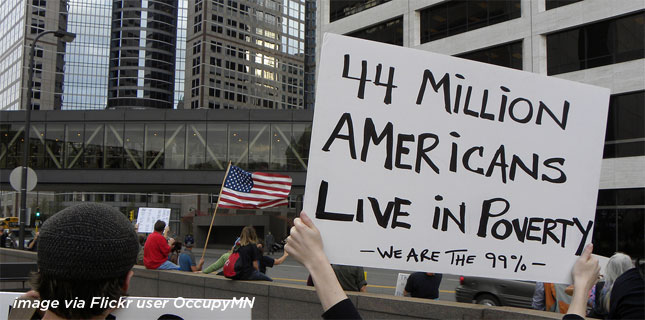
Understanding the characteristics of the poor is crucial for crafting effective anti-poverty policies. In this Economic Analysis, we document characteristics of the 46.7 million Americans—14.8 percent of the population—who lived in poverty in 2014. Using the Current Population Survey Annual Social and Economic Supplement (CPS ASEC) collected in March 2015, the source of official poverty statistics, we describe who lives in poverty as well as the characteristics of the working-age poor and those working-age poor who were employed less than full-time year-round.
Consider the following sobering statistics, illustrated in the figure above:
Just over half of those who live in poverty are of working-age, defined as between the ages of 18 and 64. Figure 2 categorizes working-age adults living below the poverty line in 2014. Among working-age adults living in poverty, 45% are in the labor force:
The remaining 55 percent of working-age adults are not in the labor force. Additional data from the CPS ASEC, which asks respondents why they are not in the labor force, allows us to further describe who these non-workers are. As a share of the total working-age adult living in poverty population:
Certainly some share of those who are disabled, a caregiver, a student, or retired—as well as the remaining small fraction outside those groups—are people who are capable of employment. As Figure 3 illustrates, a portion of those living in poverty who are disabled, a caregiver, a student, or retired are indeed in the labor force.
Though 13 percent of working-age adults living in poverty are working full-time year-round, about twice as many were employed less than full-time year-round in 2014. Figure 3 further investigates the composition of working-age adults living in poverty that reported usually working part-time and who were working part-time in March 2015.
About 40 percent of those working part-time during the year are involuntarily part-time – meaning that they would like to work full time but cannot due to an economic reason such as inability to find a full-time job, employer reduction of hours, or slack work. Just under half of part-time workers were students, caregivers, or disabled. Only about 1 in 6 of these part-time workers worked fewer than 35 hours a week or less than 50 weeks a year for some other reason.
In order to address poverty, we must first know who is poor. Using the most recently available data on poverty, we describe the population living in poverty as well as the working-age poor. This analysis suggests that most deviations from full-time, full-year employment are readily explicable in terms of factors like disability, education, or caregiving.
Download «Who is poor in the United States» »



Expositores: Oscar Vidarte (PUCP) Fernando González Vigil (Universidad del Pacífico) Inscripciones aquí. Leer más
Una retrospectiva para entender los próximos cuatro años. Leer más
En la conferencia se hará una presentación de los temas más relevantes del proceso de negociación se llevó a cabo desde el 2012, así como del acuerdo de paz firmado entre el Gobierno colombiano y la guerrilla de las FARC a finales del 2016. Se analizarán los desafíos y las... Leer más
El Observatorio de las Relaciones Peruano-Norteamericanas (ORPN) de la Universidad del Pacífico es un programa encargado de analizar y difundir información relevante sobre la situación política, económica y social de Estados Unidos y analizar, desde una perspectiva multidisciplinaria, su efecto en las relaciones bilaterales con el Perú.
© 2025 Universidad del Pacífico - Departamento Académico de Humanidades. Todos los derechos reservados.

